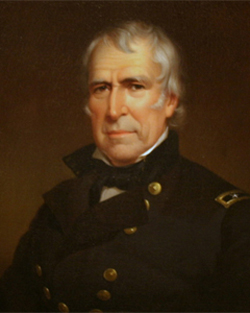Born in Virginia in 1784, Zachary Taylor spent his formative years on the western frontier in Louisville, Kentucky. There his family prospered, and by 1800 it owned a 10,000 acre plantation and twenty-six slaves. At the age of twenty-two, Taylor enlisted in the army, and after receiving his first commission as an officer two years later, served as the commander of Fort Pickering, Tennessee. In the War of 1812, Taylor saw his first major combat experience, successfully fending off an attack from the Shawnee chief Tecumseh. During the 1820s, Taylor served as commander of Fort Jesup, a small outpost near the border of Louisiana Territory and Texas (then part of the newly independent republic of Mexico). In the 1830s, Taylor gained further battlefield experience, leading U.S. troops against a coalition of Sauk, Meskwaki, and Kickapoo Indians in the Black Hawk War (1832) and as commander of U.S. forces in Florida in the Second Seminole War (1837-42).
In the summer of 1845, Taylor, now sixty years old and stationed again at Fort Jesup, was ordered by the Polk administration to defend the recently annexed Texas republic. Commanding what would now be called the Army of Occupation, Taylor moved his troops to Corpus Christi, at the mouth of the Nueces River, where he awaited reinforcements. By March 1846, with an army that now numbered 4,000, he moved further south, to the Rio Grande. When Mexican troops attacked U.S. forces in late April, President James K. Polk used the attack to ask Congress for a declaration of war. On May 18, though heavily outnumbered, Taylor defeated Mexican forces at Palo Alto; the following day he engaged the Mexican army again at Resaca de la Palma, driving it back to Matamoros.
With the United States and Mexico now at war, Taylor established a base of operations at Camargo, on the Rio Grande, while he awaited reinforcements from the War Department, which had issued a call for volunteers. In September 1846, his army now numbering 6,500, Taylor marched south to lay siege to Monterey, Mexico's largest northern city, which was garrisoned by the 5,000-man Army of the North, commanded by General Pedro Ampudia. After three days of fighting, Taylor took the city, signing an eight-week armistice with Ampudia, who was allowed to withdraw. The news of the victory was offset in Washington by President Polk's belief that Taylor had missed an opportunity to end the war by allowing Ampudia to evacuate the city. The War Department ordered Taylor to terminate the armistice immediately, and pointedly refrained from congratulating the general on his victory. This brought an immediate chill to relations between Taylor and the Polk administration, which was undoubtedly aggravated by reports that the general was being courted by the Whig party as a possible candidate for the presidency in 1848.
The rift between Polk and Taylor became even wider when Washington decided at year's end to open up a new theater of operations in the south, under the command of Winfield Scott. Ordered to assume a defensive position and place a large portion of his army under Scott's command in anticipation of an amphibious landing at Vera Cruz, Taylor refused to be relegated to a secondary role. In defiance of orders from both Scott and the War Department, Taylor pushed south, encountering the Mexican army at Buena Vista, below Saltillo. Taylor's army repulsed several Mexican assaults on February 22 and 23. Although both sides claimed victory, the battle ended in a stalemate. Nonetheless, Taylor's Army of Occupation remained firmly in control of northern Mexico, and the battle was hailed as a great victory by the American press.
The Battle of Buena Vista added further luster to Taylor's political fortunes. Known as "Old Rough and Ready" for his simple manner and modest appearance, Taylor was now the most celebrated hero of the war. Still bristling at his treatment by the Polk administration, Taylor agreed to accept the nomination of the Whig party, despite the fact that he had not been active in politics, nor did he appear to hold particularly strong political convictions. Indeed, Taylor did not share many of the core Whig beliefs, such as support for a protective tariff, the national bank, and internal improvements. Nonetheless the war hero easily defeated the Democratic candidate, Lewis Cass, whose support in the North was undercut by the Free Soil party, headed by long-time Democratic standard-bearer Martin Van Buren.
Taylor's tenure in office was dominated by the slavery controversy, which had erupted with new intensity over the status of the institution in the lands acquired from Mexico. Although the new president owned a plantation in Louisiana, southerners were dismayed when he came out publicly in favor of a plan that would admit California and New Mexico as free states. Taylor opposed a compromise package of five separate bills hammered out by Henry Clay and Stephen Douglas, a plan supported by his vice president, Millard Fillmore. Taylor's death in July 1850 from a severe case of gastroenteritis removed a serious obstacle to the so-called Compromise of 1850, which was signed by Fillmore into law in September.
Bibliography
Bauer, K. Jack. Zachary Taylor: Soldier, Planter, Statesman of the Old Southwest. Baton Rouge: Louisiana State University Press, 1985.
Eisenhower, John S. D. Zachary Taylor. New York: Times Books, 2008.
Holt, Michael. The Rise and Fall of the American Whig Party: Jacksonian Politics and the Onset of the Civil War. New York: Oxford University Press, 1999.
Silbey, Joel. Party over Section: The Rough and Ready Presidential Election of 1848. Lawrence, Kansas: University Press of Kansas, 2009.
Smith, Elbert. The Presidencies of Zachary Taylor & Millard Fillmore. Lawrence, Kansas: University Press of Kansas, 1988.

